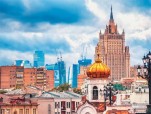High-Rise Moscow. Beyond Business District

In continuation of our overview of Moscow new high-risers, we should note that the city has not fully defined its attitude to high-rise construction principles for the recent 20 years. During these years the government tried several approaches to localize them but it has not found the best solution. The concepts of a separate cluster similar to La Defense were considered, and then reflected in the construction of the City to a certain degree. (We touched on that in the previous issue of TB magazine). By practical consideration was launched fundamentally different approach realized in construction of point block skyscrapers. But still there was not worked out any overarching urban strategy. Today the compositional principles, as well as stylistic unity and other parameters, still remain rather controversial and highly debated by the professionals. The customers are also different in the way they voice their preferences and it affects the nature of the new buildings under construction.
In the 1990 Moscow development was actively compacted. There was rather aggressive integration of new highrise towers into the space of already existed blocks erected in 1960s, 1970s, and 1980s. The average storey level of most residential districts got significantly higher. With this background it was fairly reasonable that the high-rise buildings and even skyscrapers that popped up in various Moscow districts were also supposed to be residential. (It should mention that the main business district was designed and gradually constructed in the City).
By the early 2000s in Moscow there were several high-rise buildings accomplished and they had a significant impact on the entire skyline of the capital. They were not always successful, but most houses, especially those outside the center, turned out quite large-scale and memorable.
The “Don-Stroy” company played a significant part in the high-rise construction of that period. The emphasized pseudo-historical direction of the first wave of its skyscrapers formed a certain local architectural fashion trend and in its turn influenced the type of requests and expectations of the customers. Other large builders and developers like “Mirax Group”, “Capital Group”, etc. focused on the universal international aesthetics of various late-Modernist versions to a greater extent. They offered more austere architectural solutions as far as decoration is concerned. The “Krost” concern developed the style of the new Moscow high-risers of the mid- 1990s–2000s on its own. It invited famous foreign specialists in order to form an optimal synthesis of local customers’ preferences and achievements of Western technology.
Full content of this issue you can read here
The full version of the article can be read in our printed issue, also you can subscribe to the web-version of the magazine
 Text by MARIANNA MAEVSKAYA
Text by MARIANNA MAEVSKAYA


